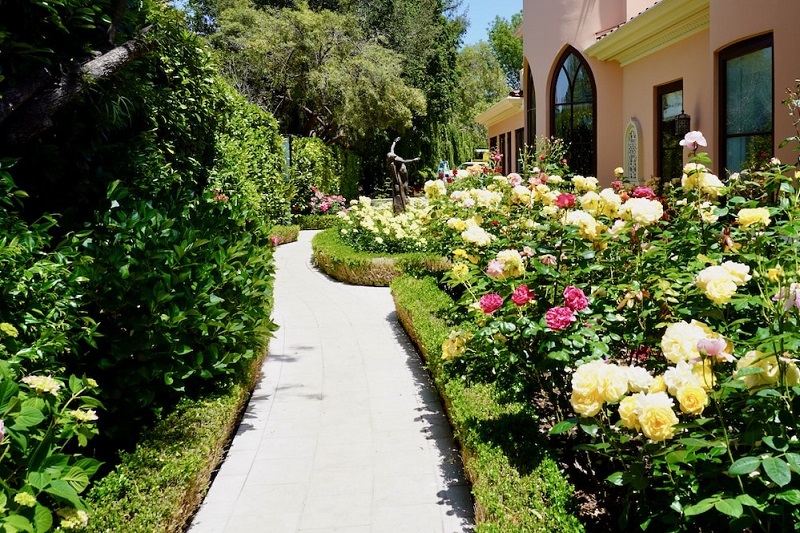Many individuals face the seasonal challenge of allergies, which can significantly affect their outdoor experiences. In this article, we’ll explore how strategic luxury landscaping plays a crucial role in mitigating these issues. From understanding common allergy-inducing plants to selecting low-pollen alternatives, we’ll cover a wide range of topics to help you create an allergy-friendly garden that ensures you can enjoy the outdoors without the sneezes and sniffles.
Understanding Allergenic Plants and Trees
1. Allergy-Inducing Plants
Firstly, it’s essential to understand the specific plants and trees that often trigger allergies. Many plants produce pollen that can cause allergies. This pollen is spread by the wind or by insects. Some common allergy-inducing plants include oak, cedar, birch, and certain types of grasses. The reason these plants cause allergies is due to the fine, lightweight nature of their pollen. When the wind blows, it carries this pollen through the air, and when inhaled, it can cause allergic reactions in some individuals. Additionally, certain plants release their pollen during specific seasons, which can make allergy symptoms more common during those times.
2. Common Allergenic Trees and Shrubs
There are several common trees and shrubs that are often found in landscapes and are known to cause allergies. Understanding the characteristics of these plants and when they’re most allergenic can help you make informed landscaping choices. For instance, oak trees are notorious for producing vast amounts of pollen. They are wind-pollinated, which means their pollen is easily transported through the air. Cedar trees are another common allergenic tree, particularly during the spring when they release significant amounts of pollen.
3. Flowers That Won’t Make You Sneeze
If you’re a fan of floral displays but want to avoid allergy-inducing blooms, there are plenty of alternatives. Flowers like roses, daffodils, and tulips are generally low-allergen options. These flowers have heavy, sticky pollen that doesn’t become airborne, reducing the risk of triggering allergies.
4. Grasses and Ground Covers
Certain grasses and ground covers can be allergenic, potentially causing issues for those with allergies. For example, Bermuda grass is known for producing pollen that can lead to allergic reactions. It’s crucial to identify low-allergen alternatives that are both visually appealing and suitable for your landscaping needs.
5. Trees for Allergy-Prone Areas
In areas prone to allergies, selecting the right trees can make a significant difference. Trees like dogwood, magnolia, or cherry trees are well-suited for allergy-prone regions. These trees have characteristics that make them less allergenic. For instance, cherry trees produce relatively little pollen, reducing the likelihood of triggering allergies.
6. Low-Pollen Plants
If you aim to minimize allergens in your garden, consider planting low-pollen varieties. These plants and trees are ideal for individuals with allergies. Plants like azaleas, hydrangeas, and hibiscus typically produce minimal pollen. By choosing these low-pollen options, you can enjoy a beautiful garden without the discomfort of allergies.
Tips for Creating Allergy Friendly Gardens

Creating an allergy-friendly garden involves selecting the right plants and trees while focusing on proper maintenance. Here are some key tips to help you minimize allergens in your garden:
- Choose low-pollen plants.
- Maintain your garden by regularly pruning and removing dead or dying vegetation.
- Consider planting evergreen trees that don’t produce pollen.
- Use ground covers that reduce soil erosion, limiting dust and pollen exposure.
- Install a good filtration system in your garden to trap airborne pollen and allergens.
1. Bay Area Local Climate Considerations
In the Bay Area, selecting plants and trees suited for your local climate is essential in managing allergenic challenges. For instance, the local climate can influence the types of plants that thrive and their allergenic potential. Understanding your region’s specific allergenic challenges and the climate can help you make the right landscaping choices.
2. Resources for Allergy-Friendly Plants
To find the best plants for your allergy free garden, explore resources that provide comprehensive information on low-pollen plants and their characteristics. These resources are invaluable for homeowners looking to make informed landscaping choices.
3. Designing with Allergies in Mind
Designing a garden with allergies in mind involves strategically placing low-pollen plants, optimizing spacing to reduce allergen exposure, and creating a garden layout that minimizes the risk of allergies. Ensuring that the design takes allergies into account can significantly enhance your outdoor experience.
4. Maintenance for Allergy Control
Regular maintenance plays a pivotal role in minimizing allergens in your garden. By keeping your garden well-manicured, promptly removing dead vegetation, and ensuring proper pruning, you can significantly reduce allergen exposure.
With the insights provided in this article, you can create a beautiful garden that is also free from allergy-induced discomfort. By selecting the right plants, understanding allergenic challenges, and implementing maintenance strategies, you can savor the outdoors without worrying about allergy symptoms.





